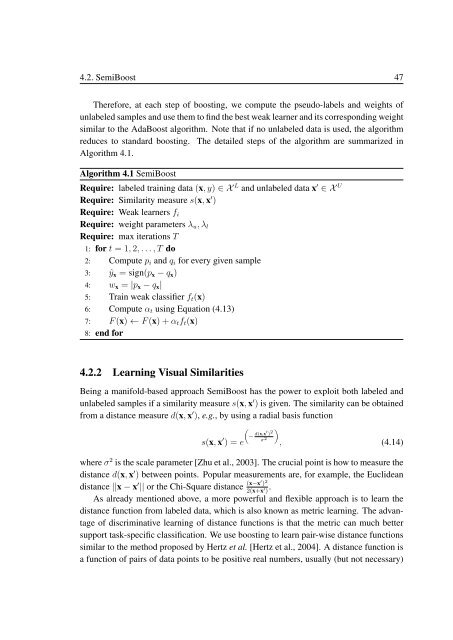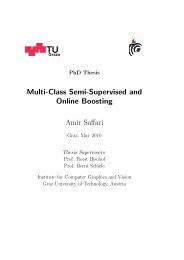PhD Thesis Semi-Supervised Ensemble Methods for Computer Vision
PhD Thesis Semi-Supervised Ensemble Methods for Computer Vision
PhD Thesis Semi-Supervised Ensemble Methods for Computer Vision
Create successful ePaper yourself
Turn your PDF publications into a flip-book with our unique Google optimized e-Paper software.
4.2. <strong>Semi</strong>Boost 47<br />
There<strong>for</strong>e, at each step of boosting, we compute the pseudo-labels and weights of<br />
unlabeled samples and use them to find the best weak learner and its corresponding weight<br />
similar to the AdaBoost algorithm. Note that if no unlabeled data is used, the algorithm<br />
reduces to standard boosting. The detailed steps of the algorithm are summarized in<br />
Algorithm 4.1.<br />
Algorithm 4.1 <strong>Semi</strong>Boost<br />
Require: labeled training data (x, y) ∈ X L and unlabeled data x ′ ∈ X U<br />
Require: Similarity measure s(x, x ′ )<br />
Require: Weak learners f i<br />
Require: weight parameters λ u , λ l<br />
Require: max iterations T<br />
1: <strong>for</strong> t = 1, 2, . . . , T do<br />
2: Compute p i and q i <strong>for</strong> every given sample<br />
3: ŷ x = sign(p x − q x )<br />
4: w x = |p x − q x |<br />
5: Train weak classifier f t (x)<br />
6: Compute α t using Equation (4.13)<br />
7: F (x) ← F (x) + α t f t (x)<br />
8: end <strong>for</strong><br />
4.2.2 Learning Visual Similarities<br />
Being a manifold-based approach <strong>Semi</strong>Boost has the power to exploit both labeled and<br />
unlabeled samples if a similarity measure s(x, x ′ ) is given. The similarity can be obtained<br />
from a distance measure d(x, x ′ ), e.g., by using a radial basis function<br />
s(x, x ′ ) = e<br />
(<br />
− d(x,x′ ) 2<br />
σ 2 ), (4.14)<br />
where σ 2 is the scale parameter [Zhu et al., 2003]. The crucial point is how to measure the<br />
distance d(x, x ′ ) between points. Popular measurements are, <strong>for</strong> example, the Euclidean<br />
distance ||x − x ′ || or the Chi-Square distance (x−x′ ) 2<br />
. 2(x+x ′ )<br />
As already mentioned above, a more powerful and flexible approach is to learn the<br />
distance function from labeled data, which is also known as metric learning. The advantage<br />
of discriminative learning of distance functions is that the metric can much better<br />
support task-specific classification. We use boosting to learn pair-wise distance functions<br />
similar to the method proposed by Hertz et al. [Hertz et al., 2004]. A distance function is<br />
a function of pairs of data points to be positive real numbers, usually (but not necessary)



